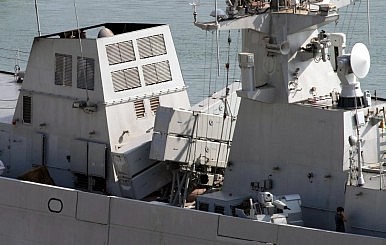May 17, 2015
On May 6, China commissioned its fourth anti-submarine warfare (ASW) optimized Type 056 Jiangdao-class corvette, the Huangshi. The Huangshi will join the People’s Liberation Army Navy’s (PLAN) North Sea Fleet as the most advanced PLAN ASW corvette. Since November 2014, China has commissioned two other Jiangdao-class ASW variants, including the Sanmenxia on November 13, 2014 for the East Sea Fleet and Zhuzhou on November 28, 2014 for the South Sea Fleet. The Diplomat reported on the inaugural Type 056 variant last November.
The 1,500-tonne displacement corvettes mark an important step in the PLAN’s ASW capabilities, an area that several analysts have noted as a weakness for China. The ASW variant Jiangdao-class ships feature four YJ-83 anti-ship missiles for surface warfare, and two triple-tube torpedo launchers, according to a report by IHS Jane’s Navy International. Additionally, the corvette’s flight deck allows for the operation of a single Z-9C helicopter (though limited maintenance facilities constrain the length and complexity of any helicopter operations).
What differentiates the ASW variants from the the 17 Jiangdao-class frigates that precede them is the inclusion of a towed array and variable depth sonar system. The inclusion of these systems indicates a focus on anti-submarine operations. China begin inaugurating its Type 056 Corvettes in 2012, and is building variants of the corvette for export. Early customers include Bangladesh, Thailand, and Nigeria.
As analysts, including The Diplomat‘s Robert Farley, have noted, anti-submarine warfare shot up the list of priorities for the PLAN over the last 24 months. In fact, one of the main tells of the PLAN’s “blue water” ambition is seen in its bid to bolster its ASW capabilities — coastal navies generally invest less into ASW capabilities compared to their expeditionary counterparts, who may find themselves on far-flung missions facing variable threats, including submarines. China’s focus on anti-access/area-denial systems was primarily intended to secure an asymmetric advantage for the PLA over a foe with greater conventional offensive strength (such as the United States).
With its new ASW focus, the PLAN is gearing up to offset threats from non-nuclear attack submarines in the East and South China Seas. Southeast Asia, for example, is currently undergoing what some have called a “proliferation” phase where submarine fleets are growing across the board. Vietnam, a claimant state to the Spratly Islands, is in the process of incorporating Russian diesel-electric improved Kilo-class submarines into its navy, posing a potential threat to China (see: “Vietnam’s China Challenge: Making Asymmetric Deterrence Work“). Submarines are seen as a worthwhile investment for smaller states fearing the prospect of a more assertive Chinese navy and coast guard. In reckoning with a South China Sea that is growing increasingly crowded with Chinese grey- and white-hull vessels, submarines are a stealthy and capable option.
Beyond the Type 056 ASW variant, China’s ASW capabilities are limited to its Y-8 maritime patrol aircraft and underwater acoustic sensors. The latter are primarily restricted to coastal use (though China’s South China Sea construction spree could lead to an expansion of its acoustic sensors into the Spratlys and Paracels, improving its anti-submarine capabilities).
* Article publicat a The Diplomat. La producció en sèrie les corbetes 056A demostren que la Xina és plenament conscient del seu put feble: les capacitats anti-submarines. La US Navy faria bé de plantejar-se d'una vegada per totes tornar a disposar de naus de propulsió convencional, però amb sistemes AIP, si no vol tenir sorpreses desagradables.


